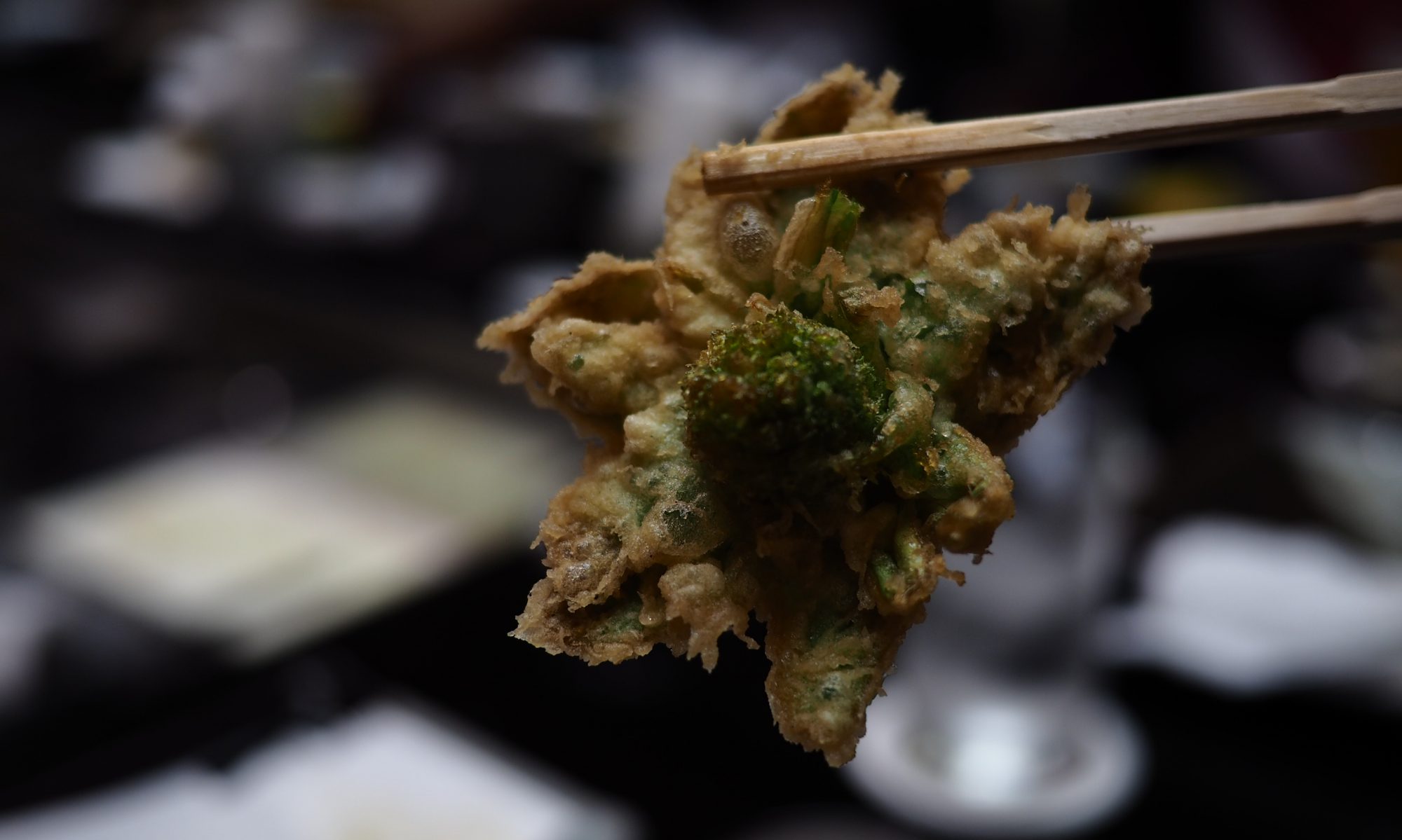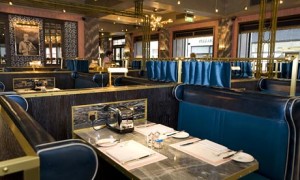 I’d been invited to Bob Bob Ricard (1 James St, Soho W1F 9DF – see the restaurant link for menus, phone and email reservations) to try a new cocktail: an English 75 with an Earl Grey syrup. What was meant to be a quick sip at the bar turned into a lengthy series of vodka shots in tiny, iced crystal glasses; a selection of really interesting cocktails; and several jewel-like little plates of Russian appetisers, the better to set off the drinks. Leonid “Bob” Shutov, one of the two owners (Richard Howarth is the “Ricard” part of the equation), spent an hour or so leading Douglas and me through the menu, structured around English club food with the odd injection of Russian standards; around the restaurant, outrageously lovely in a sort of Trans-Siberian-Express meets Japanese lacquer box way; and through the cocktail menu and extravagantly stocked wine cellar.
I’d been invited to Bob Bob Ricard (1 James St, Soho W1F 9DF – see the restaurant link for menus, phone and email reservations) to try a new cocktail: an English 75 with an Earl Grey syrup. What was meant to be a quick sip at the bar turned into a lengthy series of vodka shots in tiny, iced crystal glasses; a selection of really interesting cocktails; and several jewel-like little plates of Russian appetisers, the better to set off the drinks. Leonid “Bob” Shutov, one of the two owners (Richard Howarth is the “Ricard” part of the equation), spent an hour or so leading Douglas and me through the menu, structured around English club food with the odd injection of Russian standards; around the restaurant, outrageously lovely in a sort of Trans-Siberian-Express meets Japanese lacquer box way; and through the cocktail menu and extravagantly stocked wine cellar.
I’m not usually much swayed by good interior design in a restaurant, being approximately 95% motivated by food even when I’m not eating, but the attention to detail and quirky beauty of BBR’s dining room is so good that it acts as a seasoning. I mentioned to Leonid that I seriously, seriously coveted the wallpaper panelling the room, all midnight blue flowers and tiny flocks of sparrows sweeping in gorgeous waves across the walls. “It’s Japanese bookbinding papers. We had to do it four times before it was right; the pieces the paper is supplied in are this big.” (Uses hands to demonstrate a disquietingly small rectangle.) I spent the rest of my visit staring, but I couldn’t see any joins anywhere.
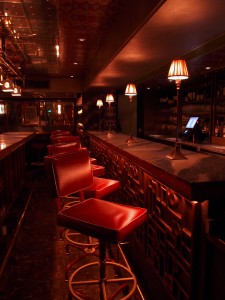
You’ll find a gold “press for champagne” button at each Pullman-booth dining table, marble panelling feathered with veining so sumptuous that I thought it had been painted on, bronze lap dogs to guard your umbrella, magnificent deco lighting, marquetry floors and handsome brass fittings. As it turns out, the restaurant was designed by David Collins (the Wolseley, Claridge’s bar, all that good stuff). It’s highly individual, and such a beautiful space that I decided I needed a spot more exposure to it. I finished my surprise lunch and immediately booked a table for later in the week – BBR was so interesting that I was very keen to see what the evening service was like, and how things go when you’re not there as a guest of the owner. (In brief, things go very well indeed – it’s a wonderfully romantic spot for an evening meal, and the quality of what was on our plates didn’t waver.)
Before you launch on anything else, you’ll need to make a cocktail/wine decision. Cocktails are superb and enjoyably imaginative (I ended up going the cocktail route with Dr W, so more on those later), but BBR’s wine cellar and markup policy are something rather special. The restaurant has a cellar to suit the wine tastes of any business tsar (sorry) you bring for dinner, but marks itself out by never charging more than £50 markup on any bottle of reserve wine. This curious bit of policy means that where you’d spend £923 on a bottle of 1999 Bollinger Vieilles Vignes at somewhere like Le Manoir aux Quat’ Saisons, that very same bottle at BBR will rock up at a positively reasonable-sounding £294. A 1986 Chateau Leoville Las Cases is £338 here (£905 at le Coq d’Argent) and, for dessert, a 2002 Chateau d’Yquem that costs £310 at Ducasse at the Dorchester is less than a third as expensive, at £96. This is still a bit too rich for my blood, but for a very special occasion, I can see myself jumping on a bottle of 03 Sassicaia Tenuta San Guido at £129 – especially given that you can’t actually find the wine anywhere else in the UK. BBR bought up the whole stock from that year.
Happily, there’s plenty available for less hair-raising prices, and plenty on offer by the glass too.
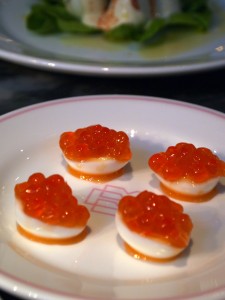
James Walker, ex of le Pont de la Tour, is in the kitchen doing all kinds of thrilling things with quail eggs and caviar. The menu here is a funny amalgam of Edwardian nursery/chophouse and Russian swank, and I loved it. The rich, salty, oily Russian starters on the menu (denoted with a little Russian flag beside each item) are the perfect foil to the gloriously austere Kauffman collection vodka or the slightly fiercer Russian Standard Imperial – drunk before a mouthful of yolky quail’s egg topped with keta (Russian salmon roe), a bite of cured herring, a darkly salted cucumber or a fork’s tip draped with a silky, beautifully fresh quail eggs mayonnaise. These little shots, clinked together in shimmering little crystal glasses straight from the freezer over some unashamedly pretty food, turn out to be a perfectly joyous way to start an evening out, and a great sharing experience with friends. And the prices on these lovely little bites (you might look to share four as a starter between two people) are very encouraging – the keta with quails’ eggs was £4.50, the herring £3.50.
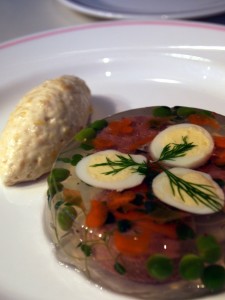
At a Russian friend’s wedding a few years ago, we ate a braised beef brisket, cooked for hours and shredded, then suspended in a disc of aspic. A delicious thing, a bit like the inside of a very jellied pork pie without the crust. Most of the wedding guests at our table were squeamish British sorts, and Dr W and I found ourselves the only people at the table to finish the dish and then to steal it off everyone else’s plates. I’ve not seen the same preparation since (despite some concerted effort at eating Russian in Helsinki), until lo – BBR has a version as good as anybody’s aspic fantasies. Here, the meat used is shredded tongue, and the little roundel of aspic is packed with sweet, fresh peas, slivers of carrot cut into fanciful shapes with an aspic cutter, threads of cress, and more dense, beefy flavour than you’d believe you could fit into such a small space. (There is also a quail’s egg in there, of course.) A little timbale of a sweet and mild Russian horseradish is a beautiful foil to what turns out to be a weirdly delicate, literally mouth-melting plate.
Although wild Beluga is available, most of what’s on offer caviar-wise is the farmed roe from Aquitaine. I’m a huge enthusiast for farmed caviar; it’s a reliable product and it’s helping to democratise the price of a very special ingredient. The nutty, pearly roe is served with blinis, or as part of an Eggs Royale – an Eggs Benedict with smoked salmon on the muffin instead of ham, a gout of really good hollandaise, a plump poached egg…and a giant dollop of caviar. It’s the first time I’ve come across caviar treated as a condiment, and thinking about the dish is still making my mouth water nearly two weeks later.
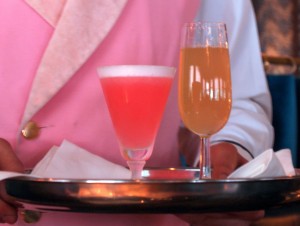 The cocktail list is enormously good fun. A rhubarb gin and tonic (the restaurant’s signature cocktail, now available year-round), made with a poached rhubarb syrup and one of the pinkest, prettiest drinks I’ve had in ages, uses a gin without too much in the way of botanicals to let the floral, rosy headiness of the rhubarb sing. There’s a clear Bloody Mary, made with the clear juices of fresh tomatoes, extracted overnight. It’s a drink that packs a glorious vine scent and a real hit of umami on the tongue. There’s intense tomato flavour with no redness – it’s positively discombobulating. You’re given a little bottle of Tabasco and some Worcestershire sauce to spice your own drink with, so the beautiful clarity of the drink isn’t spoiled before you’ve had a good chance to play with it for a bit.
The cocktail list is enormously good fun. A rhubarb gin and tonic (the restaurant’s signature cocktail, now available year-round), made with a poached rhubarb syrup and one of the pinkest, prettiest drinks I’ve had in ages, uses a gin without too much in the way of botanicals to let the floral, rosy headiness of the rhubarb sing. There’s a clear Bloody Mary, made with the clear juices of fresh tomatoes, extracted overnight. It’s a drink that packs a glorious vine scent and a real hit of umami on the tongue. There’s intense tomato flavour with no redness – it’s positively discombobulating. You’re given a little bottle of Tabasco and some Worcestershire sauce to spice your own drink with, so the beautiful clarity of the drink isn’t spoiled before you’ve had a good chance to play with it for a bit.
Pork cheek was poached in a dense, rich jus full of star anise and tomato. Glossy and malevolently dark, it’s served with some very fine Yukon Gold mash. And I went for the evening’s special, a rose veal Rossini, which came in at a positively bargainsome £24.50, giving me a great excuse to order another cocktail. I’ve always liked veal better than beef in a Rossini; the more delicate flavour of the meat works better, for me, against the strong flavours of foie and truffles in the dish, and this was cooked to a lovely pinkness, moist and tender to the tooth. My little lobe of foie was seared glass-crisp on the outsides, melting velvety-smooth inside. And the truffly, oily, garlicky smear of duck pate on the crouton that sat on the side of the plate was so good that Dr W, having been offered a bite, made a noise I haven’t ever heard before.
The plate of cakes we asked for for dessert was a bit dry, and each of the six little bites was really rather ordinary. I was so full I didn’t really care, though – and an Affogato coffee was exactly the sort of alternative I was after, the ice cream shot through with vanilla seeds.
You can go to BBR and spend your entire inheritance in one night, if you try. You can also go and, with some judicious ordering, come away with a wallet not particularly lightened. Head along at night, when the restaurant positively twinkles, explore the more curious corners of the menu, and tell them I sent you.
